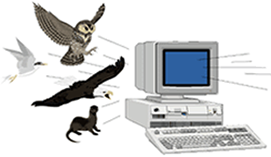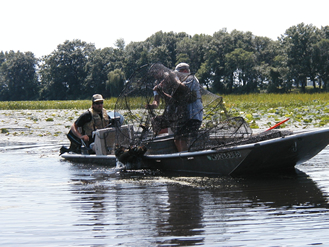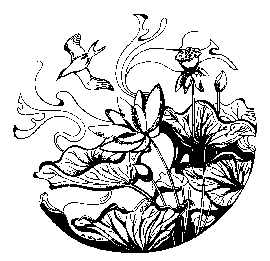- Home
- About S&T
- Taxa/Organisms
- Ecosystems
- Issues
- Methods & Tools
- Reports & Publications
- Location
- Search
Publisher: USGS | Science Center: Patuxent Wildlife Research Center (PWRC, Laurel) | Format: URL
www.pwrc.usgs.gov — Information about ecotoxicological exposure and its effects on terrestrial vertebrates residing in estuarine and coastal habitats like the Atlantic, Gulf and Pacific Coasts, Alaska and Hawaii, as well as the Great Lakes. These vertebrates include birds, mammals, amphibians and reptiles. The data is a compilation of results from computerized More...

Publisher: USGS | Science Center: Forest and Rangeland Ecosystem Science Center (FRESC, Corvallis) | Format: URL
sagemap.wr.usgs.gov — SAGEMAP - Spatial Data for Sage Grouse and Shrubsteppe Systems is needed for research and management of sage grouse and sagebrush steppe habitats in the western United States. This website is a product of the NBII Great Basin Information Project. Find out more from this resource on sage grouse as endangered species, habitat information, More...

Publisher: USGS | Science Center: Patuxent Wildlife Research Center (PWRC, Laurel) | Format: URL
www.pwrc.usgs.gov — BEST Large River Fish Health Data Query Tool provides a simplified portal for accessing database that serves fish health endpoints measured through the Biomonitoring of Environmental Status and Trends (BEST) Project's Large River Monitoring Network (LRMN). The tool allows the user to search the database by species, chemical, river basin, sampling More...

Publisher: USGS | Science Center: Forest and Rangeland Ecosystem Science Center (FRESC, Corvallis) | Format: URL
ris.wr.usgs.gov — The Raptor Information System (RIS) is a computerized literature retrieval system that focuses on raptor management, human impacts on raptors, the mitigation of adverse impacts, and basic raptor biology (with an emphasis on population dynamics and predation). The raptor contaminants database is a subset of RIS that includes references with More...

Publisher: USGS | Science Center: Upper Midwest Environmental Sciences Center (UMESC, LaCrosse) | Format: URL
www.umesc.usgs.gov — This web resource provides decision makers with the information needed to maintain the Upper Mississippi River System as a viable multiple-use large river ecosystem. This resource also includes Data and sampling information, publication links, reports, other related documents and statistics, as well as links to field stations and other projects More...

Publisher: USGS | Science Center: Upper Midwest Environmental Sciences Center (UMESC, LaCrosse) | Format: URL
www.umesc.usgs.gov — Presently, the Long Term Resource Monitoring Program (LTRMP) conducts annual monitoring of vegetation using a stratified random sampling method (Yin et al. 2000) in five study reaches of the Upper Mississippi River System: Navigation Pools 4, 8, 13, and 26 on the Mississippi River; and La Grange Pool on the Illinois River. The LTRMP will continue More...

Publisher: USGS | Science Center: USGS Other | Format: URL
gisdata.usgs.gov — This interactive GIS search tool provides a portal for accessing extant information along the U.S.- Mexico Border. The tool allows the user to search the database by place name, boundaries, transportation features, weather, hydrography, biology, geology, infectious disease, orthoimagery, land cover, and elevation.

Publisher: USGS | Science Center: Forest and Rangeland Ecosystem Science Center (FRESC, Corvallis) | Format: URL
fresc.usgs.gov — Biologists and managers on Washington's Olympic Peninsula, as throughout western Washington, are concerned about increased observations over the last several years of emaciated deer with symptoms of excessive hair-loss. This Web page describes a study to evaluate modern pellet-group survey methods, estimate abundance of deer and elk, identify More...

Publisher: USGS | Science Center: Fort Collins Science Center (FORT, Ft. Collins) | Format: URL
www.fort.usgs.gov — As one of one of the big three charismatic predators in North America, mountain lions top the list of national park management challenges that require balancing the preservation of species with protection of park visitors. In Rocky Mountain National Park and its environs, USGS Fort Collins Science Center (FORT) scientists are collaborating with More...

Publisher: USGS | Science Center: Western Ecological Research Center (WERC, Sacramento) | Format: URL
www.werc.usgs.gov — Invasion and subsequent restructuring of ecosystems by nonnative organisms is taking on increasingly urgent significance as an example of human-caused environmental change with potentially dramatic consequences. This web resource discusses the affects of vascular plants - particularly in Sequoia, Kings Canyon, and Yosemite National Parks - on the More...

Publisher: USGS | Science Center: Western Ecological Research Center (WERC, Sacramento) | Format: URL
www.werc.usgs.gov — Pinon-juniper woodlands have expanded beyond their historical range in the western United States, due partly to land management practices such as fire suppression that began with settlements of the region in the late 1880s. This woodland expansion has replaced sagebrush steppe vegetation, leading to decreased wildlife habitat, soil seedbanks, and More...

Publisher: USGS | Science Center: Western Ecological Research Center (WERC, Sacramento) | Format: URL
www.werc.usgs.gov — This issue overview focuses on nonnative grass invasions and fire in the Mojave Desert, which appear to have been infrequent historically. When fires occurred, gaps of plant-free space separating individual shrubs, bunchgrasses, cacti, and trees, stopped the spread of fires like networks of small firebreaks. The increasing dominance of nonnative More...
